
During flight training, I was taught early on about the importance of maintaining “coordinated” flight. My instructor reminded me to pay attention to the turn coordinator and explained the hazards of uncoordinated “slip” and “skid” turns.
The differences between these types of turns may seem subtle, but having a solid understanding of these aerodynamic phenomena is critical to a safe and comfortable flight.
What is the difference between slipping turns and skidding turns?
In slipping turns the nose of the aircraft is yawed towards the outside of a turn. In skidding turns the nose of the aircraft is yawed towards the inside of a turn. Both turns are considered “uncoordinated” because the horizontal lift component does not equal the centrifugal force of the aircraft.
Slips and skids can actually turn into dangerous scenarios, and in the rest of this post we’ll cover the aerodynamics of slips and skids, how to avoid or correct them, and what can happen if you don’t.
Slipping and Skidding Turns Explained and Compared
First we will explain slipping and skidding turns more intuitively, then we will discuss the specific aerodynamics and physics at work when an airplane makes a turn.
Slipping and Skidding: Intuitive Explanation
Remember that turning in aircraft involves both ailerons (roll) and rudder (yaw).
At their most basic level, slips and skids have to do with the longitudinal orientation of the airplane.
Imagine a line drawn from the nose of the plane to the tail. When turning in coordinated flight, this line will point tangent to the arc of the turn.
In other words, the nose of the airplane should follow the path of the turn.
If you use too much or too little rudder for the turn you are making, you will find yourself in uncoordinated flight as this longitudinal line points inside or outside of the arc of your turn.
If the aircraft’s nose is yawed tangent to the turn, this is considered a “coordinated” turn (explained later).
Slipping turns occur when the nose is yawed outside of the turn. This is caused by either too little rudder in the direction of the turn, or even the use of opposite rudder (adverse yaw).
Skidding turns occur when the nose is yawed inside the turn. This is caused by either too much rudder in the direction of the turn.
The diagram below illustrates the position of a plane in coordinated flight, a slipping turn, and a skidding turn. Remember that other aerodynamic concepts such as adverse yaw, relative wind, and power setting will all affect the amount of rudder needed in a turn.

Slipping and Skidding: Aerodynamic Explanation
When you are in straight and level flight, the lift force generated by an aircraft’s wings act vertically to counter the weight of the plane and maintain altitude.
When you are in a turn, things are a little more complicated. The wings still generate lift, but the lift vector is no longer acting straight up.
The lift can be thought of as being composed of two components while turning: a vertical lift component, and a horizontal lift component.
During a “coordinated” turn, the horizontal lift component will equal the centrifugal force of the aircraft.
A slipping turn occurs when the horizontal lift component is greater than the centrifugal force of the aircraft.
A skidding turn occurs when the centrifugal force is greater than the horizontal lift component of the aircraft.
The following diagram illustrates these principles:

Source: Chapter 5 of the Pilot’s Handbook of Aeronautical Knowledge
How to Identify and Correct Slipping and Skidding Turns
Slipping and skidding turns are a result of uncoordinated flight. As such, the way you identify if you are slipping or skidding a turn is by looking to see if the aircraft is experiencing coordinated or uncoordinated flight. There are many ways to do so.
Turn and Slip Indicators
The Turn and Slip Indicator displays exactly what it sounds like: the turn and slip (or skid) of an aircraft.
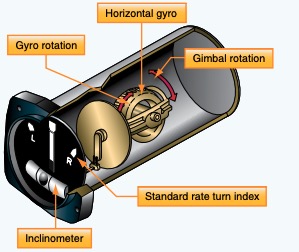
Source: Chapter 8 of the Pilot’s Handbook of Aeronautical Knowledge
The needle will point in the direction the aircraft is turning, and the inclinometer (also called “the ball”) beneath it indicates the centrifugal force of the aircraft.
Centrifugal force can be thought of as the directional momentum of the aircraft.
When an aircraft initiates a left turn, the momentum of the aircraft is still carrying it in the original straight flight path, so left rudder is required to yaw the aircraft towards the turn, in tandem with left roll from the ailerons.
The ball reveals whether or not the centrifugal force of the aircraft is equal to the horizontal lift (explained above). While simple in design, the inclinometer shows crucial information!
“Keeping the ball centered” results in coordinated flight.
A slipping turn is indicated when the ball is deflected to the inside of a turn, whereas a skidding turn is indicated by the ball being deflected to the outside of the turn.
The ball can also be thought of as the aircraft tail’s position relative to the flight path. If the ball is deflected left, that means the tail is also to the left of the aircraft’s flight path and the airplane is crabbed longitudinally to the right.
The way to correct uncoordinated yaw is to “step on the ball” which means to apply rudder pressure (yaw) in the direction the ball is deflected.
For example, if the ball is to the left, you would provide left rudder pressure to yaw the aircraft to the left and recenter the ball.
Turn Coordinators
A Turn Coordinator is similar to the Turn and Slip Indicator but it can sense both rate of roll and rate of turn.
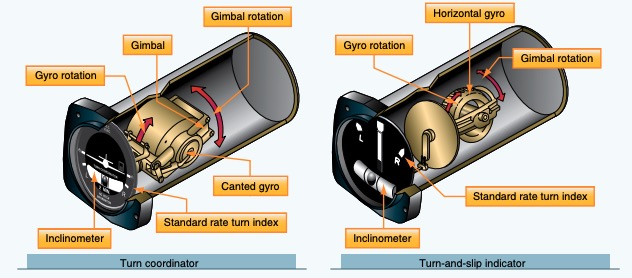
Source: Chapter 8 of the Pilot’s Handbook of Aeronautical Knowledge
Just like the Turn and Slip Indicator, the bottom half of the Turn Coordinator has an inclinometer (the ball) that indicates the centrifugal force of the aircraft.
Coordinated flight is achieved by applying rudder pressure in the direction the ball is deflected. Identifying slipping and skidding turns is just like the Turn and Slip Indicator.
A slipping turn is indicated when the ball is deflected to the inside of a turn, whereas a skidding turn is indicated by the ball being deflected to the outside of the turn.
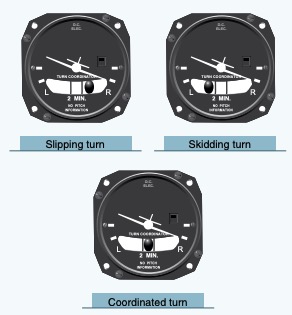
Source: Chapter 8 of the Pilot’s Handbook of Aeronautical Knowledge
Keep in mind if you suffer an electrical failure, the electrically-driven gyroscope in the bank indicator will fail and no longer provide reliable data.
However, the inclinometer (the “ball”) does not rely on electricity so it can’t fail. After all, it’s just a ball in a tube.
Turn Coordination on Glass Instruments
If you’re flying an aircraft equipped with glass avionics such as a Garmin G1000 or Aspen Evolution 1000 PFD, your turn coordination will be presented a little differently than on the gyroscopic instruments discussed above.
Bank indication: Your bank indication will be at the top of the attitude indicator.
The aircraft is represented by the upward facing white arrow, and the downward facing arrow represents wings level. The white tick marks to either side represent 10, 20, 30, 45, and 60 degree bank angles.
Slip & Skid information: The electric version of the “ball” is displayed as a white rectangle (or trapezoid) just beneath the upward facing white arrow.
Just like the ball in the turn coordinator, this white rectangle will move left and right showing left or right deflection. You can still “step on the ball” in the same fashion to correct uncoordinated flight.
Below is a representation of the G1000 environment.
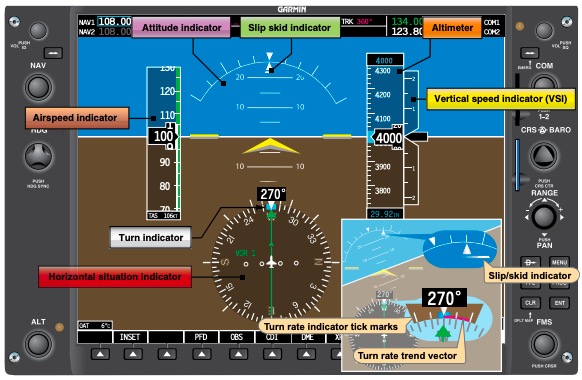
Source: Chapter 8 of the Pilot’s Handbook of Aeronautical Knowledge
Here is an Aspen Evolution 1000 Primary Flight Display showing a slight right slipping turn.
The up arrow (highlighted below) shows the climbing slight right turn, and the rectangle (digital inclinometer) shows the uncoordinated turn requiring more right rudder because it is not centered under the triangle.

Yaw string: an old-school trick to stay coordinated
A yaw string is a simple device dating back to the dawn of powered flight, still commonly used on gliders. Wilbur Wright is credited with attaching a “yaw string” to the original Wright Flyer.
A short piece string attached to the windshield can provide a very accurate and reliable indication of yaw. The relative wind will always blow the string straight backward, even while turning.
Instead of “stepping on the ball”, you step on the rudder pedal the string is pointing downward toward. This might feel backward if you’re used to using an inclinometer, but will quickly become second nature.


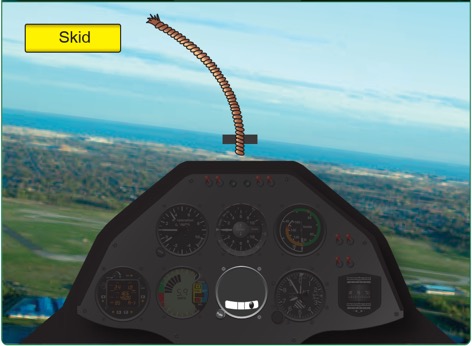
Source: Glider Flying Handbook, FAA-H-8083-13A
Best of all, yaw strings are cheap, immune to electrical failure, and will keep your eyes outside – where they should during VFR flight.
Coordinating Turns by Feel
An inclinometer and a yaw string are certainly useful tools to teach and maintain coordinated flight. As you progress in your flying though, you should aim to acquire muscle memory for coordinated flight.
In a skidding turn, you will feel like you’re being pushed to the outside of the turn (just like you do when you turn sharply in a car). In a slipping turn, you will feel lateral pressure towards the inside of the turn. During a coordinated turn, you will feel an increased G-force, but it will act straight down into the seat and not laterally.
Go fly with an experienced CFI who can illustrate these differences to you. Keeping a plane coordinated will also be more comfortable for your passengers, especially those sitting in the back seat.
Why are uncoordinated turns considered dangerous?
Uncoordinated turns can be dangerous because they greatly increase the risk of a stall turning into a spin. Uncoordinated turns near the ground (such as during takeoff or landing) that result in a stall and spin are a potentially fatal scenario if there is not enough altitude to recover from the spin.
While both skidding and slipping turns can be dangerous because they are uncoordinated turns, skidding turns actually present more of an immediate danger to pilots.
Why are skidding turns more dangerous than slipping turns?
Skidding turns are more dangerous than slipping turns because they have a higher chance of creating a spin. When in a skidding turn, the low wing has a higher angle of attack than the high wing. This means that a stall could easily develop into a spin toward the direction of the turn.
To make matters worse, a skidding turn is a common temptation for pilots during the landing phase of the flight – a dangerous (and possibly fatal) altitude to encounter a spin.
Pilots overshooting the base-to-final turn (due to wind, poor technique, or other factors) will sometimes use a steep bank angle and too much rudder to try to reposition the aircraft back on the centerline of the runway.
Because the aircraft is already slow, and bank angle increases stall speed, this is a ripe scenario for a stall.
While in a skidding turn, if the pilot uses opposite aileron to stop the turn once on final, this moves the aileron downward on the lower (inside) wing, increasing that wing’s angle of attack and chance of a stall. The outside (higher) wing aileron will move upward, lowering the angle of attack.
This can result in the inside (lower) wing stalling before the outside (higher) wing, and the airplane will roll straight into a spin on the low wing side.
In this disorienting scenario, the plane is rolling the opposite direction that you have commanded – the pilot likely won’t have enough time to react to the spin, and not enough altitude to recover.
The lesson here? Don’t turn aggressively to make your turn to the runway (you’ll have time to correct it on final), be mindful of increased stall speeds in turns, and always keep your turns coordinated.
If you don’t think you are set up for a safe and stable approach, go around and try again.
Are slipping turns also potentially dangerous?
Slipping turns are less dangerous than skidding turns because while they can still create a spin, the high wing in the turn will stall and drop first, bringing the aircraft more towards coordinated flight. There is also more time to correct the spin than if the low wing stalls first and inverts the aircraft.
This spin is said to be “over the top” because the plane will pass through a wings level attitude before spinning over fully to the right.
That’s why a spin over the top is easier to recover from than a spin that starts with the low wing of the plane (such as in skidding stalls) – you have more time to react before you’re upside down.
That being said, it is always best to avoid stalls close to the ground. They can take you by surprise and be very dangerous.
Final Advice: Get Spin Training
Unlike CFI applicants, private pilots are not required to train for spins. But because spins are an inherent risk of uncoordinated turns (particularly those occurring near stall speed close to the ground), it is a really good idea that you undergo even a little bit of spin training.
Commonly, CFIs with access to aerobatic aircraft will offer a short instructional flight where you will be able to experience spin entry and recovery at a safe altitude. Ask around your local airport or flight school to see what options might be available nearby.
Spin training will help you develop a deeper understanding and muscle memory of coordinated vs. uncoordinated flight, and also teach you what to do if you encounter a spin from a slipping or skidding turn.
Along with giving you a good understanding of what an aircraft will feel like before and during a spin, and honing your stick and rudder skills, you will likely have a blast in a new aircraft type – my few hours practicing spins in a Citabria were certainly memorable!
Fly safe out there!



